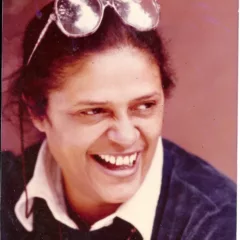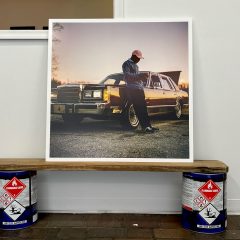A visit to Brooklyn with Alex and Lindsey last Sunday turned into a trip to the newly opened High Line, the former railroad trestle that has been converted into a park/promenade for the public in Manhattan. The park seems like a great paradigm for remaking the Reading Viaduct in Philadelphia.
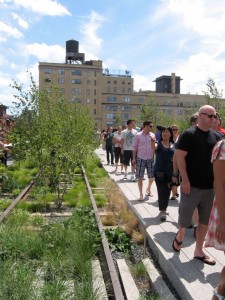
The High Line, located along 10th Avenue in the Meat Packing District and Chelsea, from Gansevoort to 20th Street, has a festive feel, a sort of public meeting space to see and be seen, a promenade. In Philadelphia, such a park would have the added pleasure of offering a sense of community plaza that the High Line can’t quite attain in the hubbub that is New York.
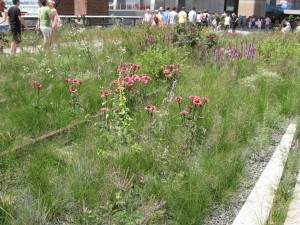
Part of what’s so great about the High Line are the stylish design decisions–the bits of rail road track preserved, the use of wild-looking plants like tall grasses that look like they could grow between neglected railroad tracks, the benches that seeming like outgrowths of the granite slabs, the way the slabs are laid out like boardwalk boards.
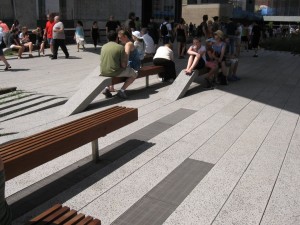
It’s this latter use of long slabs that really announce what is going on in this stretch of a dormant railroad trestle is a fashionable boardwalk.
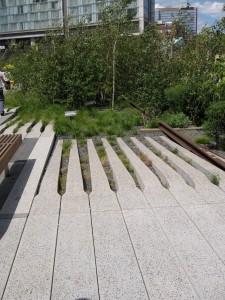
The former railroad viaduct is a bit more complicated than a boardwalk. For one thing it meanders a bit. For another, it has plants. To keep people off the plants, the designers raised the edges of the granite abutting the plants. This use of an uneven pavement maybe have been a little too subtle. With the crazy crowds and the meandering walk way–I was regularly thrown off balance when I inadvertently stepped on the raised edges. I was not the only one having this problem. Someone’s bound to get injured (but it’s not Philadelphia, so maybe they won’t sue).
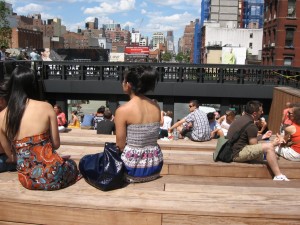
There’s lots of seating. The most unlikely and witty was stadium seating overlooking large glass panes, where people could sit and watch the cars navigate the road below. People sat there mesmerized in this recognition of basic New York life as theater!

Then there was the High Line beach–a lineup of deck chairs, and sure enough, there were women and men all bikinied out, sunning. We could smell the sunscreen! Some of the deck chairs had wheels that rolled on the railroad tracks, another witty decision. In the shade of one of the buildings beneath which the trestle passes, a couple of kiosks sold refreshments–drinks and ice cream. Tables and chairs were provided there as well.
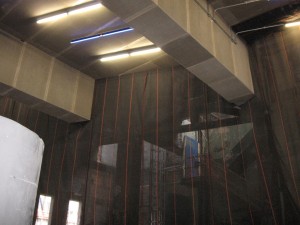
There’s also an elevator and restrooms–all the amenities needed for a friendly public space.
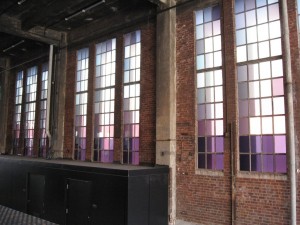
And what’s a new public construction project without an art installation? Artist Spencer Finch’s The River that Flows Both Ways, 2009, consists of 700 colored glass panels inset as factory-sized mullioned windows in a long brick wall. The colors of the panels are based on the colors of the river during one day in June, 2008, translated by photographs taken once every minute. The layout speaks to the photographs’ pixels as well as light and water and time. By the way, the title, according to a helpful sign near the installation, is a translation of the Native American name for the Hudson.
The installation is not only a seamless fit in the environment, but it is a lovely metaphor for the identity of the High Line and the river as modes of transportation and navigation through time. (Why don’t we have the equivalent of Creative Time here in Philly?)
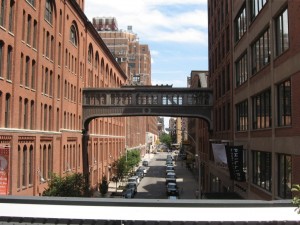
Murray, Alex, Lindsey and I all began to wonder just who owned what we were all walking on. We overheard a bit of one of the many walking tours available on the High Line. The speaker said the owner is not the city but a holding company. But we got shooed away before we could hear more. The web site seems to me to contradict this:
November 2005
The City takes ownership of the High Line from CSX Transportation, Inc., (which donates the structure), and the City and CSX sign a Trail Use Agreement.
So I would go with the web site for accuracy. Or maybe those two things aren’t mutually contradictory. What do I know about high finance? There’s a ton of information on the web site about the history of the railroad and the current project and its financing. It wouldn’t be a neighborhood project without a “Friends of” organization. Sure enough, there’s a Friends of the High Line. And the park is a joint project of the Friends and the City of New York.
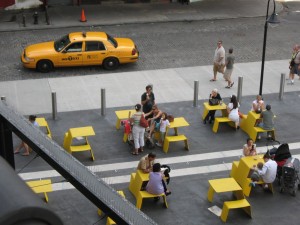
Some of the wonders of walking on this elevated promenade include new views of the tops of buildings that otherwise go unnoticed, views of the Hudson River and views of pedestrian bridges, some of them quite ornate, connecting buildings.
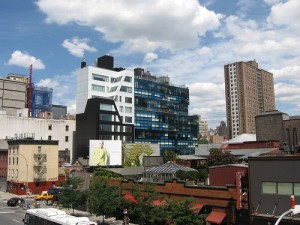
The changes to the area around the High Line are striking, turning the grungy Meat Packing District into a place to see and be seen, with trendy cafes and high-tech plazas.
The crowd on the day we visited was haute bourgeoisie, well heeled and out for a fashionable afternoon in the sun–they were almost too kempt and civilized for primo people watching. I missed the range of characters that make the boardwalk at the shore such an adventure.
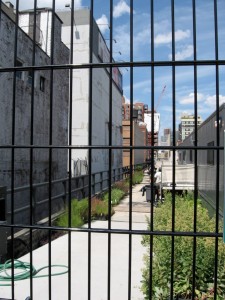
We wondered if ice, wind and snow would force it to close in the winter? And how long it would take until homeless people discovered the nice places to bed down in comfort, either on the deck chairs or in the grasses or under the shelter of the buildings that the High Line punches through. There are a number of employees up there, apparently to keep things under control. Groundskeepers chide people for stepping on the plantings; information people distribute brochures; guards of various sorts keep a lookout. According to the web site, if the High Line gets too crowded, access will be limited to the entrance at 16th Street. So this place requires a certain amount of vigilance to keep the atmosphere upbeat. I have to assume there’s a lot of money going into this upkeep!
Anyway, the second segment, already begun, is scheduled for completion (up to 30th Street) in 2010. Now, Philly, let’s get going on our own Part One. There needs to be some civic will here, in the city that hates to change.


